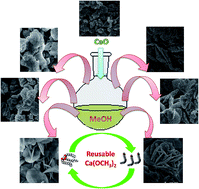Hydrothermal effect on synthesis, characterization and catalytic properties of calcium methoxide for biodiesel production from crude Jatropha curcas
Abstract
Hydrothermal synthesis is a well-suited approach for preparing bulk metal catalysts with high purity as it is cost-effective and easy to control in terms of temperature and time. In the current study, an effective catalyst for transesterification of high fatty acid content of crude Jatropha curcas oil (JCO) was appraised. Calcium methoxide (Ca(OCH3)2) has been successfully synthesized via a green and economical hydrothermal process at different synthesis times. CaO was used as a precursor as it is abundant, inexpensive and environmentally friendly. Ca(OCH3)2 can form on the surface of CaO and its active basic surface is very well developed. This facile experimental strategy without any surfactant or template produced porous Ca(OCH3)2 with a high surface area and high basicity, which leads to a superior catalytic reaction and is a promising alternative for short-reaction-time solid-based catalysts in biodiesel production in terms of excellent transesterification performance and long durability. The performance of synthesized Ca(OCH3)2 was examined by characterizing it using analytical techniques such as TG-DTA, XRD, BET, FT-IR, TEM and SEM. Ca(OCH3)2 catalysts had three types of morphologies, i.e. (a) irregular round shape particles, (b) a well arrangement of plate-like structures with rough surface and (c) a cluster of tiny plate-like architectures with smooth surfaces. The correlation between synthesis time, surface area and morphology of catalysts and the biodiesel yield was studied. Ca(OCH3)2 was able to maintain the FAME content above 86% after a fifth cycle, at optimum reaction conditions of 2 h reaction time, 12 : 1 methanol/oil molar ratio, 2 wt% catalyst loading and 65 °C reaction temperature. Ca(OCH3)2 is a solid heterogeneous catalyst for the transesterification reaction of non-edible Jatropha curcas oil for biodiesel production. The catalyst can be separated easily from the reaction mixture and reused to give a consistent transesterification activity.


 Please wait while we load your content...
Please wait while we load your content...